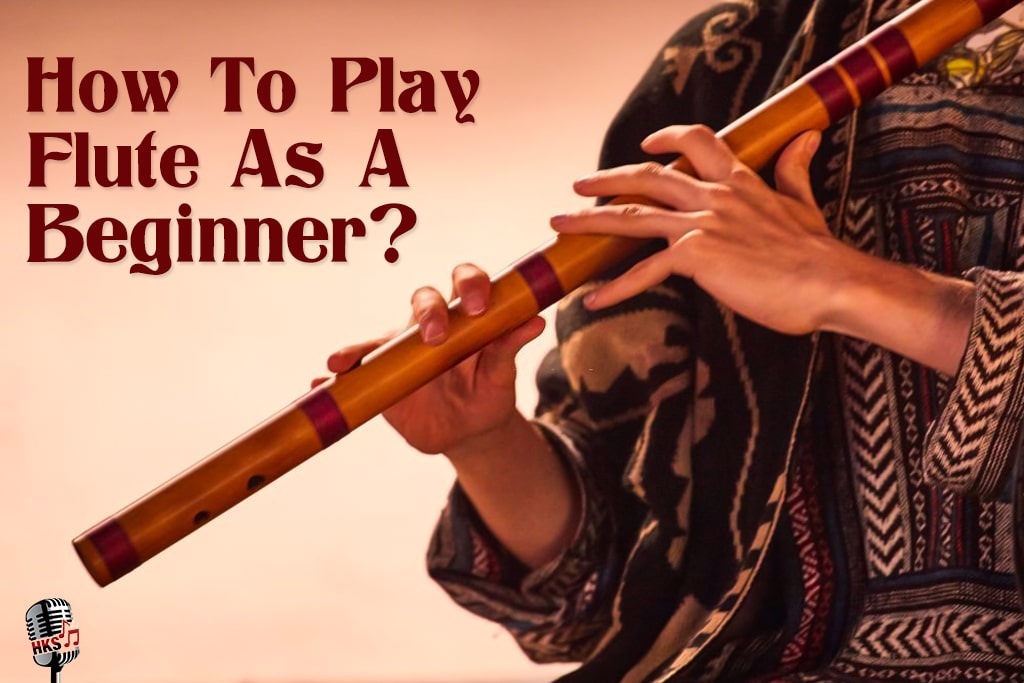Black Friday Store Wide Sale | 35% Off | USE COUPON CODE - BLACKFRIDAY35

Playing an instrument certainly doesn't seem an easy task. It takes a lot of energy, time, patience, practice, and perseverance. When we look at musicians playing, it seems easygoing and fluent at the moment, but we know what goes behind. Although I am not trying to scare you off, anyone can learn to play an instrument with immense trying and understanding. So is the case with a beautifully toned instrument called a flute. The flute has a melodic rhythm that fits perfectly in a Backing Track, and many artists use it to give their song a lively vibe. The flute is often seen being played in an orchestra and admired by many, but in order for you to learn flute, you'll need to have an understanding of its fundamental aspects from notes, functioning, components to posture. The flute can be learned like any other instrument with diligence and perseverance. Although in order to understand how the instrument is played, you first need to understand its components.
Components of Flute:
Understanding the working of any instrument should start with understanding its components. The flute is made up of a single piece and three different sections. The first section is the head joint or the neckpiece; through this, the player blows air into the flute. After the neckpiece comes the middle joint, also known as the lip plate. The player puts his lips onto the lip plate, which is joined in the neckpiece, and this goes on to create a sound that then turns with the help of flute keys into the desired synchronised rhythm.
Flute keys are covered with metal keys or plates that come in two styles: covered keys, also known as (German-style) and ring keys that are also known as (French-style). Flute keys are a part of the middle joint or middle section of the instrument's body. These keys help in building higher or lower pitches. After the middle section comes the foot joint, it is a small section with a small number of keys through which the instrument's sound flows. The foot joint is where the right hand of the flute player is, and the left hand should be nearer to the player.
Assembling of the Flute:
In the beginning, you should know that learning an instrument requires patience, and you'll not be able to grasp every bit of that in just one go. The player should aim for smaller goals, such as learning a single note thoroughly and, once learned if not mastered, then move on to the next one. Some of the notes or keys will be easier than others; it's better to master those easily understandable or the ones your fingers find easier to play, then build up the difficulty level key by key and then focus on the tempo. Before starting with understanding notes and how the instrument is played, let's firstly understand how it is assembled.
- To begin with, when assembling a flute, we need to first look at the disassembled flute and understand the perplexing pieces to put together. As stated above, the flute comes in three parts: the head joint, the body, and the foot joint. The head joint is the top part of the flute with a lip plate. The middle joint is the most significant part of the instruments with multiple keys. In contrast, the foot joint is the smallest part of the instrument.
- After taking out the flute and cleaning it, take the head joint, the part opposite the lip plate, and insert it in the part of the instrument's body with bare metal that does not have any keys. The insertion should be done gently with little to no force, which might damage the instrument. The lip plate of the head joint should align with the keys in the body and should be centred; this can be done by gently twisting the pieces together until the alignment is achieved.
- The next step is to attach the foot joint with the body. The foot joint can quickly be joined to the body by attaching the two pieces while noticing that the first key of the foot joint is aligned rightly to the keys of the body. All you have to do is smoothly twist both pieces until they gently align with each other.
- After all the pieces are gently assembled, try playing the flute. If the instrument sounds off, adjust it accordingly. For this, you can take the help of a tuner to tune your flute. It should be kept in mind that you should always clean your flute gently, and to reach the internal part, you can always use a swab to clean the internal areas. The flute should be taken care of and played gently.
How to Play the Flute?
Now that you have learned how a flute is assembled, we can understand how you can play the flute as a beginner. On the road to understanding playing the flute, you first need to consider the significance of the proper posture. The posture plays a prominent role in playing the flute correctly, and it is one of the most awkward and complex parts that flutists face at the start. Although it is crucial to learn the flute, the correct posture develops consciously with time and practice. Young children especially find it harder to hold their flute with their tiny hands upright.
Anyone can learn the proper posture; it is to be kept in mind that you're sitting in an upright position with your spine kept straight. Your head and shoulder should make a square position and hold the flute in a way that your body is neither leaning forward nor backward. While your body is held upright, it should be comprehensible that your body is calmed and in a comfortable space without any rigidness. The flute should be played with ease and comfort, with your hands flexibly moving in the directions of the keys.
The flute is a kind of instrument that primarily relies on your intuition. That being said, for you to learn it, you'll need help from a teacher or an online course that will teach you the correct posture and breathing pattern required to play the instrument. In addition, the flute has its notes, articulation, skills, and music theory. Some of these steps might help you learn a brief understanding of playing the flute.
- First, you need to hold the flute in a position where the keys on the head joint which controls the instrument should be held by your left hand. Your thumb should rest on the first key of the bottom part of the body while your index finger should rest on the 2nd key, your middle finger should be kept on the 4th key, and your ring finger should be kept on the 5th key. Your pinky finger should reside on the side key while the space between your thumb and index finger holds the weight of the flute.
- Coming on to the right hand, the thumb of your right hand should hold the bottom of the flute while you focus on the three bottom keys of the body. You should keep a space between your palm and your flute so that you will easily be able to put your fingers on the rest of the keys. Put your index finger on the first key of the bottom half of the body. Place your middle finger on the second key of the bottom half of the body and while doing so, place your ring finger on the last key of the bottom half of the body. Your pinky finger of the right hand should rest on the first key of the foot joint. Your hand should make a C-like shape while resting your fingers on the keys.
- The end of the flute needs to be tilted in a downward position. While you keep your body and spine straight, the arms need to be relaxed, and the position of your flute should be parallel to the ground while you raise it closer to your mouth.
- The hole beneath your mouth should be kept under your bottom lip as the flute lays parallel to the ground and rests on your chin. The hole should be directly in a position where it is centered and aligned with your upper lip. The corners of your mouth need to be tight while keeping your lips relaxed. You can do so by mouthing the word 'M' and tightening the corner of your mouth but not so much that your lips don't move.
- Now mouth the word 'P' and slightly blow the air from between your lips, don't widen the lips too much, or else the air won't pass through the instrument. The flow of air through the flute's body will then create notes. If you don't hear a sound coming from the instrument, gently lean your jaw forward.
- The next step is to move your tongue so that it mouths as 'too.' The constant movement of your tongue while blowing the air from your mouth will help separate the notes. The tongue can move faster or slower as per your pace, requirement of the note, and ease of learning. To determine the lower and higher pitch, you need to control the speed of your breath. Breathing deeply and exhaling slowly between the holes will help you get a lower pitch. In contrast, tightening the corners of your mouth and exhaling fast would get a higher-pitched sound. With practice and perseverance in controlling your airstream, you can control the pitch and sound.
- The last tip is that you can take the help of the fingering charts to learn different notes. You can also take the help of instructive videos, books, or courses to understand fingering charts. You can even learn on your own which finger needs to press which keys and how the notes are to be played, and with utmost practice, you can aim for perfection.
To Sum Up-
The flute is a sophisticated and impressionable instrument that serves the tune of many famous and graceful tracks. When you learn flute or any other instrument, it adds value to your personality and opens options for your career. Like every other instrument, the flute takes absolute time and effort to learn. Starting and learning the basics thoroughly as given above could result in fundamental clarity and understanding of the instrument. There is a whole lot of information available on the internet to know and learn about different musical instruments. This could help you get a deeper insight into how musical instruments work and keep growing your interest further. You can also learn to play the flute and other instruments with the help of karaoke. Several available mediums and websites, such as the Hindi Karaoke Shop, serve you with the best of the tracks in karaoke online.
At last, all that it requires for you to learn the instrument round up to patience, perseverance, time, interest, and practice. Of course, critiquing yourself and comprehending where you went wrong with the notes and pitch would also help unlearn and relearn. But that being said, you should not undermine or downplay the efforts you put in and the result you get.








Saurabh Namdev
3 years ago
The blog is well-written as you have explained all the points in very understandable terms.
Adil Shaikh
3 years ago
The tips you provided are helpful for me, as it actually works, and now everything is simple to understand.
Harsh Thakur
3 years ago
I enjoy playing the flute, but I find assembling one to be more challenging. So thanks for your tips.
Saurabh Jain
3 years ago
There is no doubt that the flute adds value to a person's personality and gives a better career outlook.
Yogesh Sahu
3 years ago
It's another kind of love to play the flute!
Utkarsh Nande
3 years ago
My passion for the flute goes beyond simply playing it; it's much more than that, and I've been playing it since I was 10. So yes, a big heart for flute fans.
Amandeep Walia
3 years ago
The flute is a magical instrument. There's nothing better than playing the flute!
Akshay jain
2 years ago
well-structured and informative guide for beginners looking to learn the flute.
Ram Shah
2 years ago
This blog provided an excellent beginner's guide to learning the flute. The instructions on flute assembly, proper posture, and playing techniques were clear and easy to follow. I found it extremely helpful in getting started on my flute learning journey. Thank you!